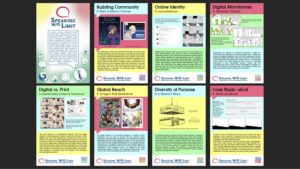So This Is Neat
I want to introduce you to Dr Leah Misemer, who is a postdoc at Georgia Tech¹ and assistant director of GT’s Communication Center. She researches comics, how they can be used by marginalized audiences to find community, and the use of comics in the fields of medicine and allied health. She teaches students about using comics as a mechanism for civic engagement, and to think about all the ways that comics reach audiences.
She’s had students in her Webcomics And Digital Culture course doing research on the structural nature of webocmics, and the niche they occupy in the online landscape. The resulting exhibition (which is, appropriately enough, online) is now up and running, and you may wish to check out Webcomics, Print, And Digital Culture: Speaking W/O Limit.
The exhibition is built around a series of collections, each examining a central theme:
- Building Community looks at everything from how audiences congregate in forums to how the societally disadvantaged can find places to congregate without fear or judgment.
- Online Identity looks at how authors can express themselves through their creations, particularly via autobio comics.
- Digital Affordances looks at the unique capabilities of online vs print; alt-text, animation, the sheer scope of Homestuck are all present, but so is the bit where you can change Dinosaur Comics to alternate forms by messing with the URL.
- Digital Vs Print is exactly what it says on the tin; it might be a superset of the other themes, in fact.
- Global Reach is probably the collection you should read first, in that we here at Fleen have (by necessity of language if nothing else) a clear tendency towards English-language webcomics in general, and North American webcomics in particular (the efforts of FSFCPL notwithstanding). Even accounting for that, there’s a whole dang world out there making webcomics, and we don’t really talk about them except for when The Nib introduces us again to somebody doing great work in yet another corner of the world.
- Diversity Of Purpose looks at how webcomics can always find a niche. A webcomic can be about depression or transition or cancer, or it can be about wacky things that happen in a library, or even (in a few cases, at least I’ve heard of such) about a coupla’ guys on a couch playing videogames. It’s all fair game.
- Case Study: xkcd, which was chosen because it exemplifies all of the other themes in one handy combo platter of stick figures. So, so many stick figures.
There will be interpretations you don’t agree with², there will be stuff that leaves you scratching your head³, but I can pretty much promise it’ll make you consider aspects of this weird, wonderful world o’ webcomics that had never occurred to you before. And ten internet points to anybody that can produce arguments for which of the theme criteria Fleen meets.
Spam of the day:
I’ d tried everything to beat my E.D… But when I injected Thai street drugs directly into my penis… Let’ s just say, things went too far. They nearly amputated my ” Johnson” with a scalpel…
This email, in case you were wondering, features the subject line Secrets to perfect female satisfaction, but appears to have completely forgotten the clitoris. So, yeah.
_______________
¹ It is not known if she is a ramblin’ wreck.
² I found the Digital Vs Print and Digital Affordances sections to be overlapping substantially, and would have personally combined them into one collection, adding in a collection examining how webcomics typically are creator-owned and do away with editorial/corporate control over material. A webcomic’s audience is the reader, where a corporate comic’s audience is the editor or publisher. This idea is, to be fair, addressed to a degree in the Diversity Of Purpose collection.
³ For example, whoever described Girls With Slingshots as The webcomic follows a group of friends who are all members of the LGBTQ community and their day-to-day experiences seems to have overlooked a raft of characters (Maureen, Clarice, Candy, Hazel’s mom, Jameson, Melody, Chris, Zach) and especially how Hazel — who is arguably the closest stand-in for the creator — is sometimes uncomfortable with her best friend’s queerness.
There’s also a description of Scenes From A Multiverse using few digital affordances, which overlooks the polling feature that SFAM was originally designed around. I get it, students at GT are in demanding majors and this is a humanities elective; they don’t necessarily have time to go back through a decade or more of archive. But I will never understand how anybody described Homestuck as convenient while keeping a straight face.

The above comments are owned by whoever posted them. The staff of Fleen are not responsible for them in any way.